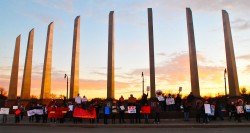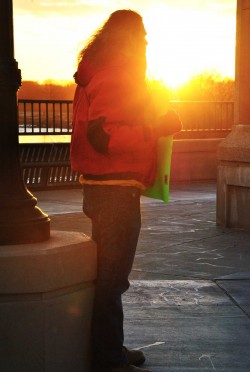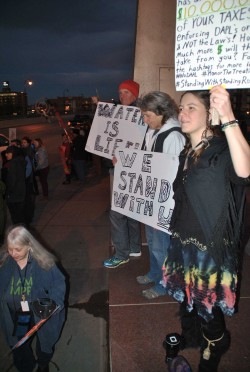News | November 16th, 2016

By C.S. Hagen
FARGO – From San Francisco to Washington D.C., Maine and Massachusetts to Arizona, Mandan to Fargo, tens of thousands of activists marched against the Dakota Access Pipeline on Tuesday in a nationwide call to action initiated by the Standing Rock Sioux.
The No DAPL National Day of Action was issued before a long-awaited victory for the Standing Rock Sioux tribe and supporters, when the U.S. Army Corps of Engineers temporarily denied Energy Transfer Partners the rights to drill under the Missouri River at Lake Oahe on Monday.
Energy Transfer Partners has less than one week to make good on its vow made approximately eight days ago to begin drilling under the river.
The leader behind the pipeline is confident that under President-elect Donald Trump his company will finish the job, according to an interview with Kelcy Warren on CBS This Morning last week. “We will get this easement and we will complete our project,” Warren said on CBS This Morning.
Trump holds a minor position in Energy Transfer Partners, and Warren invested USD 103,000 into Trump’s presidential campaign.

Warren also stated in the CBS This Morning interview that it is naïve to think Standing Rock and the tribe’s supporters will stop the Dakota Access Pipeline, and that he is ready to reimburse the state of North Dakota for the millions various agencies have spent during the controversy.
In between Fargo and Moorhead, the Minnesota Public Interest Research Group or MPIRG, organized a rally against the Dakota Access Pipeline over the Red River of the North on the Veterans Memorial Bridge. Approximately 200 people from both sides of the river joined the National Day of Action rally. Many waved banners saying “No DAPL” during rush hour traffic. Cars honked in response. Only a few pickup trucks revved their engines loudly while driving by.
Police officers did not order the activists from the bridge. No streets were cordoned off to the public. No tear gas or pepper spray was used. No rubber bullets were fired. During the 90-minute rally one police car drove past.
“One of these days I would like to see us fill the whole bridge,” Willard Yellowbird said. Yellowbird is a liaison for the Native American Commission and has traveled to Standing Rock before. He’s seen the front lines, and hopes one day the tribal flags and flags from across the world will come to North Dakota’s largest city to support Standing Rock.
“Here we are, just a support group in a spiritual way,” Yellowbird said. “They’re the front line people, we’re here to support them through financing, through prayer, through energy.
“We send them all our strength and spirit and energy from here.”

Elizabeth Arroyo, from Moorhead, plans on visiting Standing Rock in December to assist a Nicaraguan group with translation work. She took a stand on Veterans Memorial Bridge because she’s worried about the native heritage and their sacred sites becoming rubble, she said.
“It’s the weak who always suffer,” Arroyo said. “America should be an example for the rest of the world to follow.”
Most people wanted the U.S. Army Corps of Engineers to shut DAPL down permanently, but they also realized if that wasn’t an option, a reroute should be considered. Some like musician and sportsman Iron Ike, hopes oil never flows through the Dakota Access Pipeline.
Everyone who gathered Tuesday evening was concerned about how the Native Americans and supporters are being treated.
“I’m just appalled at the level of unnecessary violence,” Adam Heckathorn, from Moorhead, said. “North Dakota really needs to make progress. This is what a third-world country does, and that’s what I see over there.
“If their complexion was a little paler, I doubt they would be shooting rubber bullets.” He helped friends hold up a cardboard sign that read, “Dalrymple spent $10M on DAPL Law Enforcement.”
“Look at us here today,” Heckathorn said. “Nobody is shooting at us.”
Namarie Dansuri-Keating and her friends follow the controversy in the news. Some think the pipeline should be rerouted; other friends want the pipeline gone for good, but all her friends, she said, believe Native Americans are being mistreated.
Two hundred miles away in Mandan a very different scene unfolded along the BNSF railroad track near an oil workers’ man camp. A group calling themselves the “Black Snake Killers” and other supporters carried a message to the camp: “No more stolen sisters.”
Activists spoke from megaphones, describing how the rise of man camps in western North Dakota have coincided with a parallel increase in meth addicts, crime, murder, and human trafficking on indigenous reservations.

Men took the front lines; women formed circles to sing and pray.
“We can’t have any more of our sacred women disappearing into these perverted man camps, all they care about is making money, satisfying themselves,” said Julie Richards, founder of Mothers Against Meth Alliance, or M.A.M.A., at Pine Ridge, South Dakota.
Her war pony, or car, has been smashed. Guns have been held to her head, she said, because of her work with M.A.M.A. Before an audience of hundreds, she spoke of days when the US Army sent smallpox into native tribes, and then quickly followed with trading liquor. She called it liquid genocide. Today, Native Americans are still threatened, but this time by methamphetamines. “Our reservations are a cash crop for these cartels,” she said. “Meth is poison. Chemical genocide. We will not put up with them anymore.”
Richards’ daughter became hooked on crystal meth three years ago, she said, and Richards has been fighting the cartels and drug distributors ever since. She started M.A.M.A. to help raise awareness, and as a support group for families suffering from similar circumstances.
Morton County Sheriff’s Department’s description differed from the activists’ message. Nearly 400 activists shut down the BNSF railroad by moving a pickup truck onto the tracks, then slashed its tires and placed brush under the vehicle.
“A rope attached to the vehicle was soaked in kerosene and protesters attempted to ignite the vehicle,” Morton County Sheriff’s Department reported. “State troopers used an extinguisher on the rope to stop the fire.”
Activists hindered law enforcement from making arrests, Morton County Sheriff’s Department stated, which resulted in officers using less-than-lethal force.

Activists were shot with pepper spray, sponges, and beanbags, and one activist was shot with a Taser, Morton County Sheriff’s Department reported. Law enforcement made 29 arrests in conjunction with the No DAPL National Day of Action. The total number of activists arrested is now 478, according to Morton County Sheriff’s Department.
Other marches in North Dakota included a rally at the Morton County Law Enforcement Center. Additionally, 50 people marched on the local U.S. Army Corps of Engineers office, and another 100 people on the United Tribes Technical College, Morton County Sheriff’s Department reported.
One of the arrests occurred at Turtle Hill, a short distance north from Cannonball after an activist allegedly trespassed on U.S. Army Corps of Engineers’ land, Morton County Sheriff’s Department reported.
In Washington D.C., at the front doors of the U.S. Army Corps of Engineers headquarters building, Standing Rock resident Ladonna Brave Bull Allard said her homeland is now a war zone. She talked of the injustices her family and others experience on a daily basis.
“The police officers who have pulled out of this engagement with Standing Rock, I honor them,” Allard said. She is the daughter of a police officer, and said the events she has witnessed at Standing Rock are not honorable. “Stereotypes are still predominant in America today. Why is that? We are all just human beings. We’re asking for a basic human right to protect the water… and we have a right to live. And so today, we ask the Army Corps to stand by that, who is supposed to be protecting the water, the people, the environment, we ask them to stand against Dakota Access Pipeline.”
December 16th 2025
November 14th 2025
October 13th 2025
October 13th 2025
October 6th 2025
__293px-wide.jpg)
_(1)_(1)_(1)__293px-wide.jpg)

__293px-wide.jpg)
_(1)__293px-wide.jpg)
_(1)__293px-wide.png)